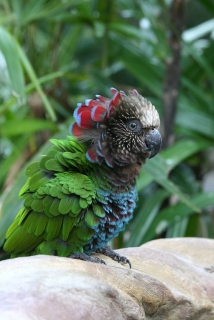Hawk-headed Parrot |
|
|
Also known as: Red-fan Parrot, Hawk-headed Caique, Northern Red-fan Parrot, Southern Red-fan Parrot
Photos
View in GalleryDid You Know?
In fear, aggression or playful behaviour the Hawk-headed Parrot will raise the feathers on its nape to form a fearsome looking fan, to make itself appear bigger.Academic Research
Related publications: Deroptyus accipitrinusSpecies Profile
Genus: Deroptyus | Species: accipitrinus
Size:
35cm (13.6 in)
Weight:
190-277g (6.6-9.7 oz)
Subspecies including nominate:
two: D.a. accipitrinus, D.a. fuscifrons
Colour Adult:
D.a. accipitrinus: Both adults forehead and crown soft white; dark brown lores; feathers of occiput and sides of head brown, streaked with soft white; long feathers of hindneck dark red, edged with blue; upperparts and lower underparts green; breast and abdomen dark red, strongly scalloped with blue; tail green with hidden maroon at base. Bill grey/black. Eye ring grey, eye yellow.
D.a. fuscifrons: Both adults forehead and crown dusty brown, faintly streaked soft white; maroon at base of tail absent.
Colour Juvenile:
Forehead cream/buff; crown brown, streaked cream/buff; area towards hindcrown washed with green; scalloping on breast green/blue. Bill paler grey with horn coloured spots at base and cutting edge. Eye ring grey/white, eye grey.
Call:
Chacking sounds, high-pitched squealing noises. Variety of chattering and whistling notes at rest. Courtship bugling and musical whistles. Some calls resemble those of the Black-headed Caique (Pionites melanocephala).
Listen NowVideo Links:
Video 1 | Video 2More Information:
Content Sources:
CITES
BirdLife International
Cornell Lab of Ornithology/Birds of the World
Parrots: A Guide to Parrots of the World, Juniper and Parr, 1998
ML Media Collection Catalogue 88397, Red-fan Parrot Deroptyus accipitrinus, Marantz, Curtis, Mato Grosso, Brazil, Oct. 9 1997, Cornell Lab of Ornithology. Site
Parrots of the World, Forshaw and Cooper, 1989. 2010 edition
Parrots of the World, Forshaw, 2006.
Parrots in Aviculture, Low, 1992.
Photos
View in GalleryDid You Know?
In fear, aggression or playful behaviour the Hawk-headed Parrot will raise the feathers on its nape to form a fearsome looking fan, to make itself appear bigger.Academic Research
Related publications: Deroptyus accipitrinusSpecies Care
Captive Status:
Fairly common
Longevity:
About 30 yrs.
Housing:
Walk-in enclosure, minimum length 3m (9.8 ft).
Diet:
Fruit such as: apple, pear, orange, cactus fruits, pomegranate, etc, forming about 30 percent of diet; vegetables such as: carrot, celery, green peas and beans, fresh corn; green leaves such as: Swiss chard, lettuce, dandelion; spray millet, small seed mixture with limited oily and sunflower seed; cooked beans or pulses, and complete kibble.
Enrichment:
Toys to wrestle with and hang upside down with, ladders, swings, puzzle toys, bird-safe wood and leather chew toys.
Nest Box Size:
Not recorded.
Clutch Size:
2 to 4
Incubation Time:
25-26 days
Fledging Age:
9 weeks
Hatch Weight:
11g (0.4 oz)
Peak Weight:
Not recorded.
Weaning Weight:
Not recorded.
Photos
View in GalleryDid You Know?
In fear, aggression or playful behaviour the Hawk-headed Parrot will raise the feathers on its nape to form a fearsome looking fan, to make itself appear bigger.Academic Research
Related publications: Deroptyus accipitrinusSpecies Wild Status
World Population:
Unknown, decreasing.
IUCN Red List Status:
Least Concern
CITES Listing:
Appendix II
Threat Summary:
Some regional decline in E of range due to widespread deforestation; threatened by wild-bird trade, which often results in high mortality.
Range:
D.a. accipitrinus: North of Amazon River from Amapa, NE Brazil and Guianas to E Venezuela, in NE Bolivar and probably SW Amazonas, SE Colombia, in E Vichada and south of Rio Guaviare in Guainia and Vaupes, SE Ecuador, in S Pastaza and northern Morona-Santiago, and NE Peru, along Rio Pastaza in Loreto.
D.a. fuscifrons: South of Amazon River, in N Brazil from northwestern Maranhao west to upper Rio Madeira and tributaries, and south to upper reaches of Rios Tapajos and Xingu, N Mato Grosso and possibly N Bolivia.
Habitat:
Found in lowland rainforest, prefering terra firme formations, like gently undulating or foothill terrain. Up to 400m (1312 ft).
Wild Diet:
Feeds on leaves and buds of Bombacopsis, unripe fruits of Dialium sp., fruits of Euterpe, Attalea sp and Jessenia, fagifolia, Astrocaryum sp. Also leaves of Spondias mombin, seeds of Jacaranda copeia, Caraipa densiflora, Licarria alba, pulp and seeds of Tetragastris, fruit of Ocatea globifera and Dialium guianense. Also takes Inga and guava in cultivated areas.
Ecology and Behaviour:
Not very gregarious, occuring in pairs or small groups of 3-4. Roosts in tree crowns in small groups, possibly singly in tree cavities. Mainly feeds in canopy.
Clutch and Egg Size:
2 to 4 ovate to elliptical eggs, 36.0 x 26.0mm (1.4 x 1 in).
Breeding Season:
February-June, Venezuela; January-April in the Guianas; December-February, Brazil. Nest is in tree cavity.
Related Links:
Photos
View in GalleryDid You Know?
In fear, aggression or playful behaviour the Hawk-headed Parrot will raise the feathers on its nape to form a fearsome looking fan, to make itself appear bigger.Academic Research
Related publications: Deroptyus accipitrinusMembers Only Resources
Please log-in now to find more research, resources and tools.
Not a Member?
Find more great information:
Gain exclusive access to 600+ pages of additional research, seminars and podcasts, specialists to ask your toughest questions, and dozens of other fun resources - when you become a WPT member.
Join Today >>

































